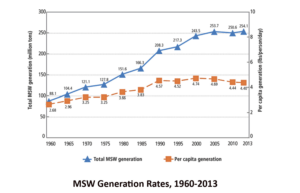Waste Management is Cleaning Up its Act
Every year we continue to generate more and more waste that has ripple effects that go well beyond our local communities, increasing the global importance of innovation in the environmental services industry. Now, more than ever, we need to start cleaning up our act.
Every single day, the average American generates approximately 4.4 pounds of waste, representing 1.7 pounds more than the average American produced in 1960. This results in approximately 254 million tons of waste per year, 55% of which ends up in one of the 3,500 landfills in the United States. Roughly 87 million tons of this waste is recycled (equivalent to a 34% recycling rate, a rate that has been slowing over the past several years)[1]. While there are many factors contributing to the growing amount of waste disposed in our landfills (see exhibits below), to put it simply, we must address the waste management industry’s growing problem if we intend to seriously combat climate change.
How Climate Change Affects the Environmental Services Industry
Municipal solid waste landfills are the second-largest source of human-related methane emissions in the U.S., accounting for 22% of all methane emissions in 2008[2]. Methane is one of the more dangerous greenhouse gases contributing to climate change; this is a serious problem because of how costly the problem is to fix. For waste haulers, the adoption of climate change legislation or regulations restricting emissions of greenhouse gases could significantly increase operating costs, thus deteriorating margins within a very competitive industry landscape. The Prevention of Significant Deterioration and Title V Greenhouse Gas Tailoring Rule, adopted in 2010 by the Environmental Protection Agency (EPA), expanded the EPA’s federal air permitting authority to include the six greenhouse gases. This increased regulation has introduced new challenges for waste players, driving industry consolidation over the last six years[3].
In addition to regulation, the waste management industry may be materially affected by extreme weather patterns, which in the past have caused service disruptions due to severe storms and extended periods of inclement weather or climate extremes resulting from climate change. “One-time” weather-related extremes, given their unpredictability, may result in significant start-up and clean-up costs that hurt profitability, affect logistics operations, and contribute to pollution.
Waste Management
One Company that has been directly affected by the aforementioned regulation and physical manifestation of climate change is Waste Management, Inc. Waste Management (NYSE: WM), based in Houston, Texas, is North America’s leading provider of comprehensive waste management environmental services, offering services to nearly 27 million residential, industrial, municipal and commercial customers in the U.S., Canada and Puerto Rico. As of December 2015, the Company owned or operated 104 materials recovery facilities, 244 solid waste landfills, 5 hazardous waste landfills, and 297 transfer stations[4]. In addition, WM operates a collection of 26,000 transfer vehicles, representing the 34th largest trucking fleet in the world (and the largest in the waste management industry)[5].
Climate Change Initiatives
In 2008, WM revamped its sustainability initiatives to combat the growing challenges related to climate change and to better cooperate with increasing regulations. First, WM has pushed a successful “circular economy” initiative, resulting in an 18% reduction in CO2 emissions in 2014, and setting a goal to further reduce emissions another 20% by 2020[6]. The Company has been able to achieve this by taking discarded materials (metal and paper) and funneling them back into the manufacturing process, rather than mining and extracting resources that contribute to increased emissions and strain demands on natural resources. The optimization of their trucking fleet and the 21 M&A deals closed since 2012 have also played a role in reduced emissions[7]. Next, WM has raised the awareness for recycling in the U.S., particularly in recycling paper and plastics. Management now claims plastic makes up a smaller percentage of waste by weight[8]. Finally, the Company has been at the forefront of the waste to energy (WTE) movement, arguably one of the most innovative solutions within the environmental services industry. Using landfills, WM is able to produce over 550 megawatts of electricity, which is enough to power more than 440,000 homes. This amount of energy is equivalent to offsetting over 2.2 million tons of coal per year[9].
A Roadmap for the Future
While Waste Management has been a leader in sustainability in the environmental services industry, the Company can still do more to address the increasing scarcity of clean water. Climate change and pollution from landfill contamination are contributors to the lack of access to clean water in certain developing countries around the world. We as a society are at risk of the ripple effects related to poor human welfare conditions and deteriorating standards of living, especially as globalization continues. The next step will need to be the intensification of educational programs and company led promotion related to climate change and clean water initiatives that bring sustainability to the forefront of business and political leaders’ minds, an awareness that will hopefully result in responsible business practices in an era of continued growth.
(782 words)
[1] Advancing Sustainable Materials Management: Facts and Figures. Environmental Protection Agency. 2013 Report.
[2] Environmental Protection Agency website.
[3] Waste Management 2015 Earnings Call.
[4] Waste Management 2015 Annual Report.
[5] Fleet Central Top 100 Fleets Database.
[6] Waste Management 2015 Sustainability Report.
[7] S&P Capital IQ Database.
[8] Waste Management 2015 Sustainability Report.
[9] Waste Management Website.






I appreciate you including an article about the trash industry and methods to reduce the environmental impact. While an undergraduate engineering student I had the opportunity to visit a Waste Management Waster Energy facility, owned by a previous subsidiary Wheelabrator. One of the additional benefits of the waste to energy process was the ability to extract metal following the burning process. They had vibrating tables that removed the ash leaving the metal products on the conveyor and then a large magnet used to separate the ferrous and non-ferrous. The extraction of the metal was a win-win for the company since it provided them an additional revenue stream and reduced the amount of landfill space needed for the ash.
I am a big fan of Waste Management’s push towards waste-to-value and recycling initiatives, but I do wonder how the economics of these various projects pan out. The methane-gas to electricity projects are usually fairly low yield, so I wonder if it is only corporate or government players who can afford to invest in these kinds of projects (because of longer term capital and reputational benefits) as opposed to private investment funds. On the recycling end, I’m also curious what the unit economics of reselling the various waste streams are – e.g. plastic vs. metal (as Robert Nesbit mentioned).
This post does a great job in highlighting the opportunities within the waste management industry to manage and mitigate climate change. As Catherine brought up, the most interesting question for me is around the economics of investing (and the model of investment) in new waste management technologies. How can we ensure the incentives are aligned such that we can maximize investment in these types of technologies that are critical for our sustainable future.
Companies like Waste Management will have to play a critical role if we are to move toward a circular economy. Given their purview into the various waste streams, Waste Management can collaborate across industries with companies that are trying to make more sustainable, recyclable and reusable products. For example, Waste Management could partner with a company like Nike to optimize the “cradle-to-cradle” lifecycle of their products. At the very least, these types of collaborations can help inform Waste Management’s investments in technologies and processes while also informing Nike’s product development and design choices.
As I’ve read a lot of the other posts here, as well as the IKEA case, it’s becoming increasingly apparent to me that companies like Waste Management play a critical role in the circular economy solution. One great example that you pointed out is filtering scrap metals back into the economy, which replaces metals that would otherwise have to be mined. I imagine one of the biggest issues with this is the actual mechanics of separating materials into the right groupings. The immediate solution that comes to mind is consumers – if we all separated our waste ourselves then that would solve that issue. However, affecting large scale change in consumer behavior is challenging. On the other side of the equation, the sheer volume of waste we generate makes it impossible for companies like Waste Management to do it all.
I am interested to learn more about the waste to energy movement. My initial question when I read this was: is producing energy from waste a clean way to produce energy? Overall, it seems that it could be a risky endeavor to utilize waste to produce energy as it could result in an even higher level of pollution per unit of energy produced. I would be interested to learn more about exactly how the WTE processes function and exactly how much valuable energy the system can produce. If the system actually does produce energy in a clean manner it would be interesting to see how many current landfills could be dug up to create more energy using the WTE system.
Waste management is a specially interesting topic regarding sustainability and this article very well lay out the particularities with the different type of waste and different type of management needed. Specially in developing countries, the lack of infrastructure in waste management is much aggravated by climate changing, with stronger and longer rains. Particularly in Brazil, we have a lot of waste that are not treated yet and I had the opportunity to visit one of the few landfills with treatment (http://www.haztec.com.br/solucoes-ambientais-completas/). Even in such company, with a lot of engineer behind it, the climate change was still a issue. The warmer whether made the particles evaporate and travel farther, causing health problems in neighbor cities.